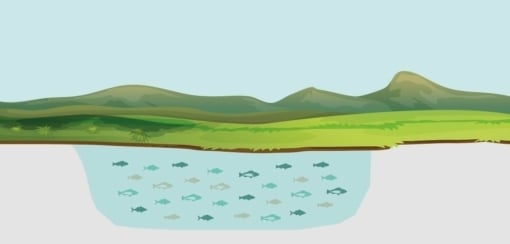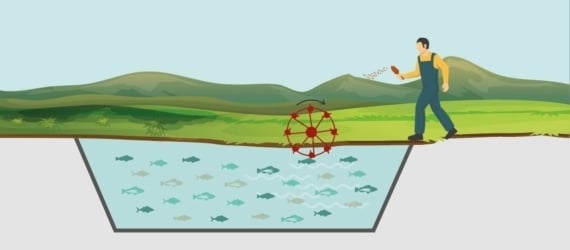
The environmental impact of farmed seafood is largely determined by the farming method used.
Fish farming, may take place in the ocean, lakes, or on land.
Here is a summary of some common aquaculture methods.
Traditional (extensive)

Let’s start with traditional farming. In traditional trout farming, the water is borrowed from a river or spring and after using its oxygen, the water is returned to the river or stream. All the faeces, TAN and CO2 are discharged untreated. This is a very basic way of farming using nature’s resources. There are seasonal influences, which means a high water temperature variation throughout the year which limits the growth season. Also low water availability in summer can be chalenging. Disease risk from wild fish and birds spreading pathogens. Costs are low and so is the productivity, 200 kg/l/sec on average. Normally low energy diets are used because they are relatively cheap and always work in the variable conditions. Here the oxygen level of the water is the limiting factor.

Semi-intensive
By aerating the water at the inflow, the oxygen level can be increased to 100%. This can be done with paddle wheels or cascades.Now the stocking density can be increased and the yearly production as well. On average, the productivity can be increased by 50% to 300 kg per l/sec/year. The risk is still low since no pumps areneeded and during a power failure, the biomass will not die immediately. Medium energy feeds are generally used as they give a better FCR than low energy diets which further support the higher productivity. In this way, the higher costs can be more than compensated for. The limiting factor is still oxygen, but in the summer with less water available and a large biomass, CO₂ and ammonium can also become suboptimal and hence limiting. The bottom farm is spring fed and this has the advantage that such water is pathogen free. You have to be careful when buying eggs and fingerlings to maintain the disease-free status.
Intensive

Another step further is intensive trout farming. Intensive trout farming is characterized by using liquid oxygen and O2 levels far above 100% at the inflow. A minimum oxygen level, well above minimum requirement, at the outflow is maintained at all times. Now the stocking density can be increased again because much more oxygen becomes available to the trout. The costs increase but so does the productivity! Now about 900-1000 kg per l/sec/year can be produced. For these situations, high energy diets are needed as they give fast growth and a low FCR. Trout growth is largely related to energy intake and although such diets are more expensive, the better performance outweighs the costs. The farm becomes dependent on energy and generators are needed to take over when there is a power failure. Now the available water is used to its maximum when oxygen is concerned. The limiting factors are now CO₂ and ammonium.

